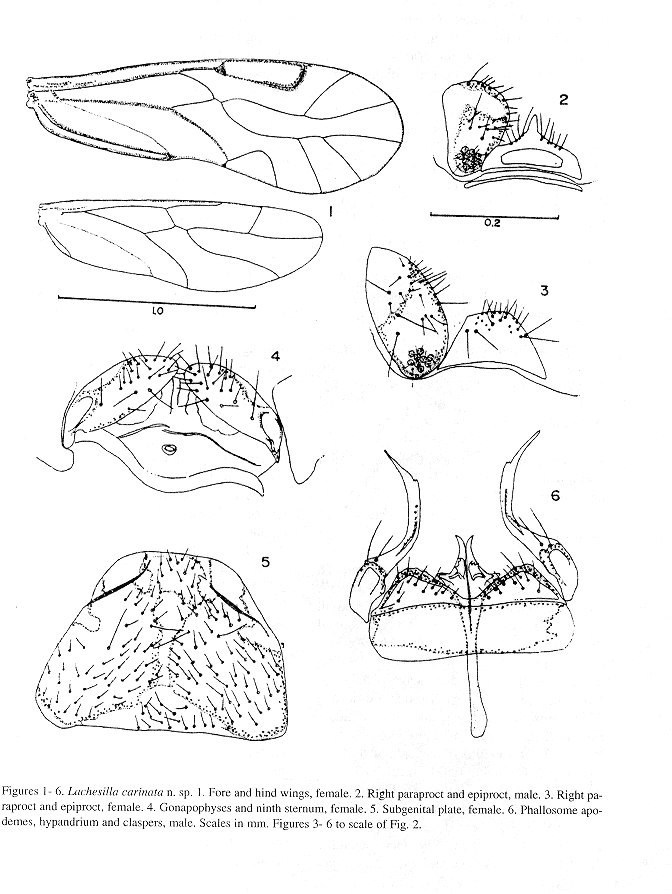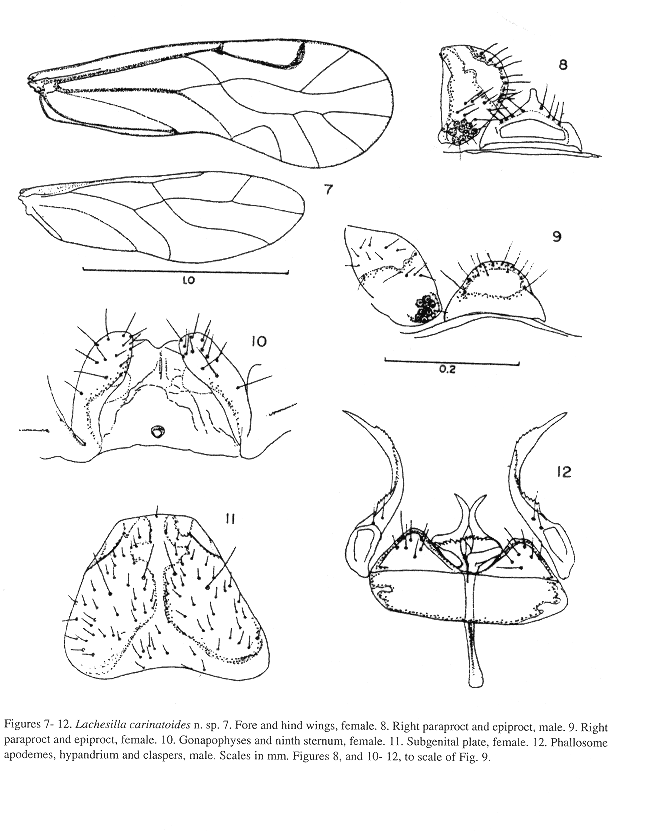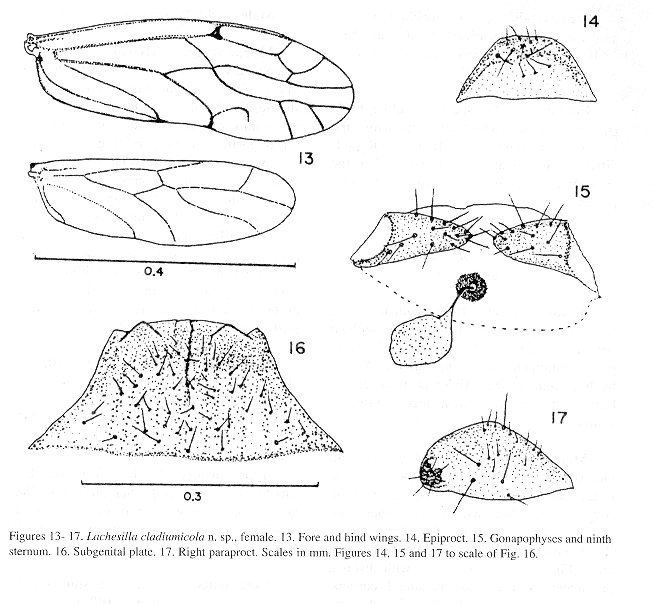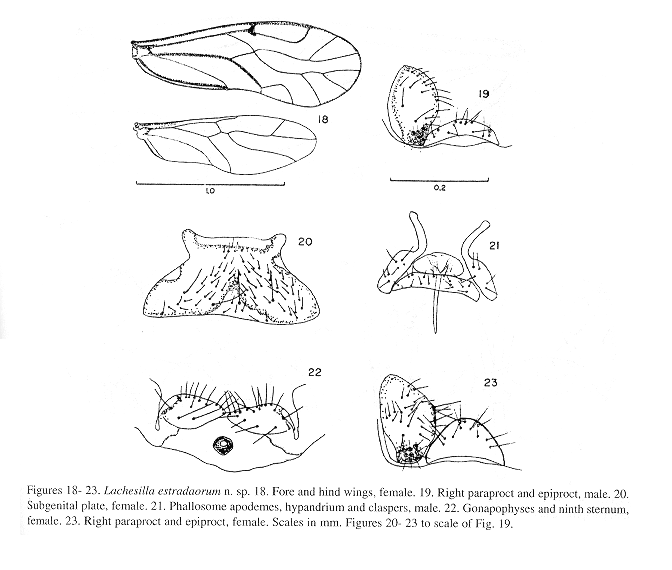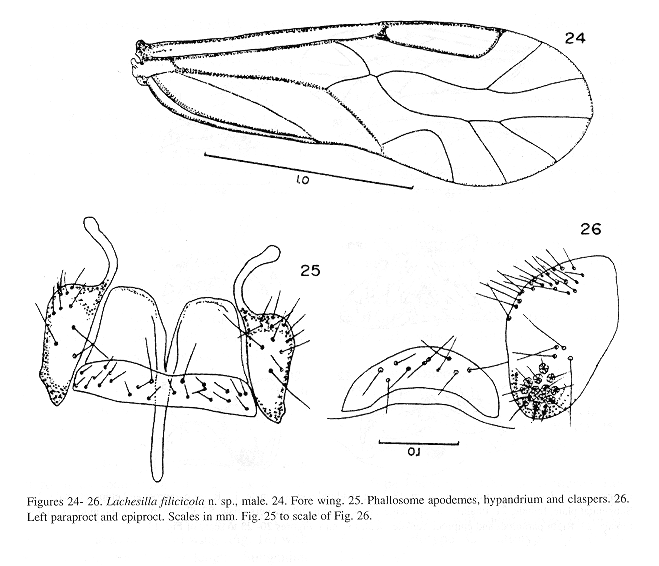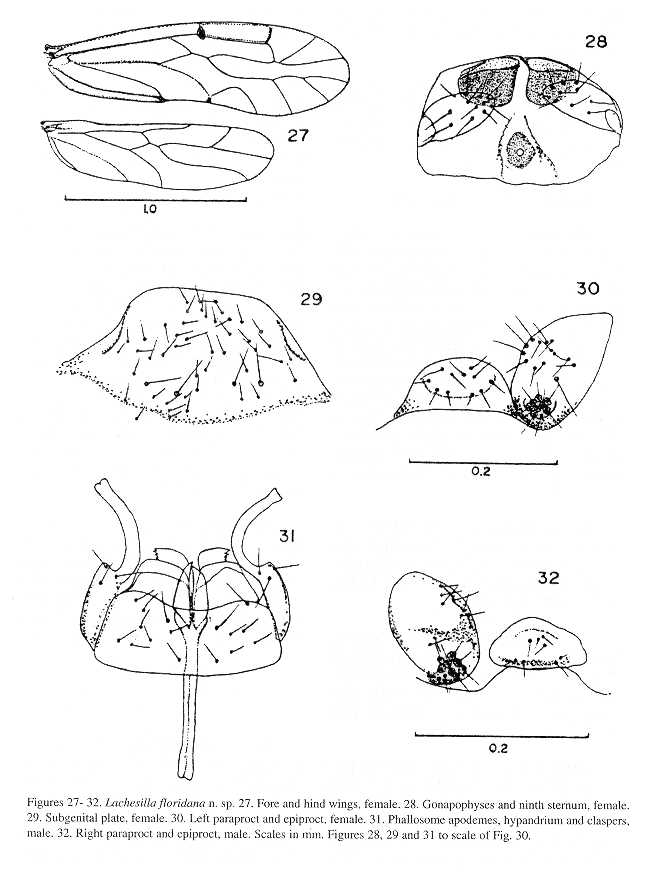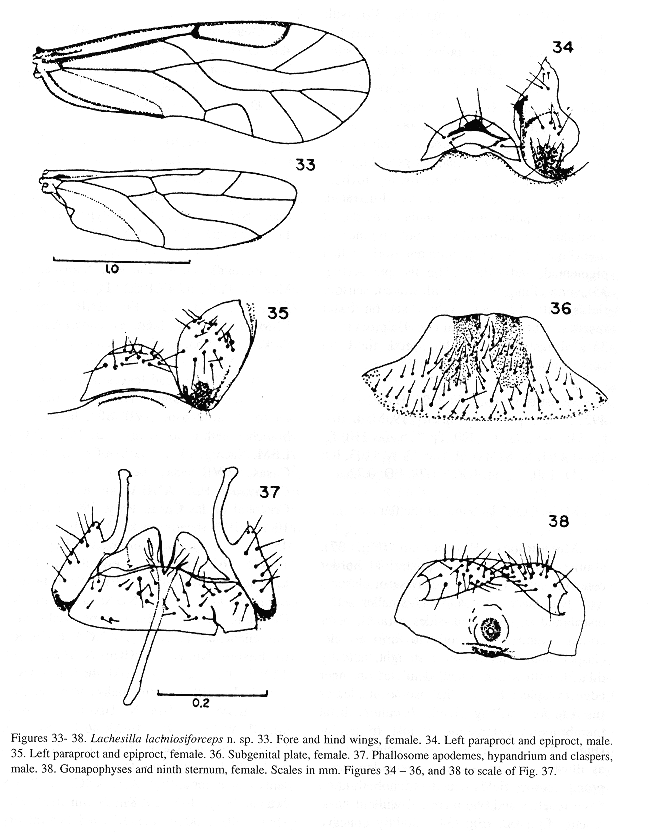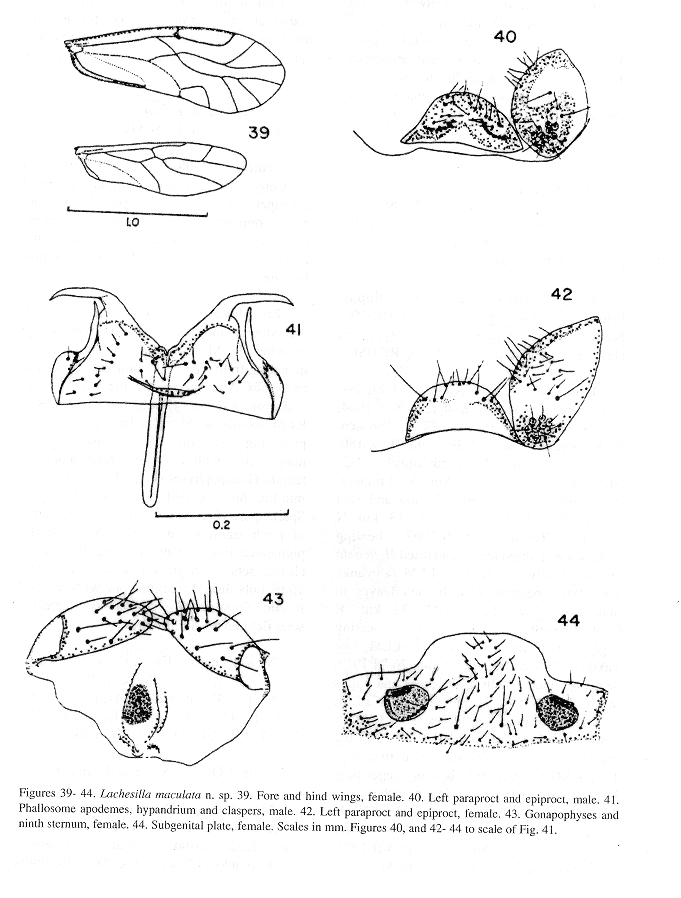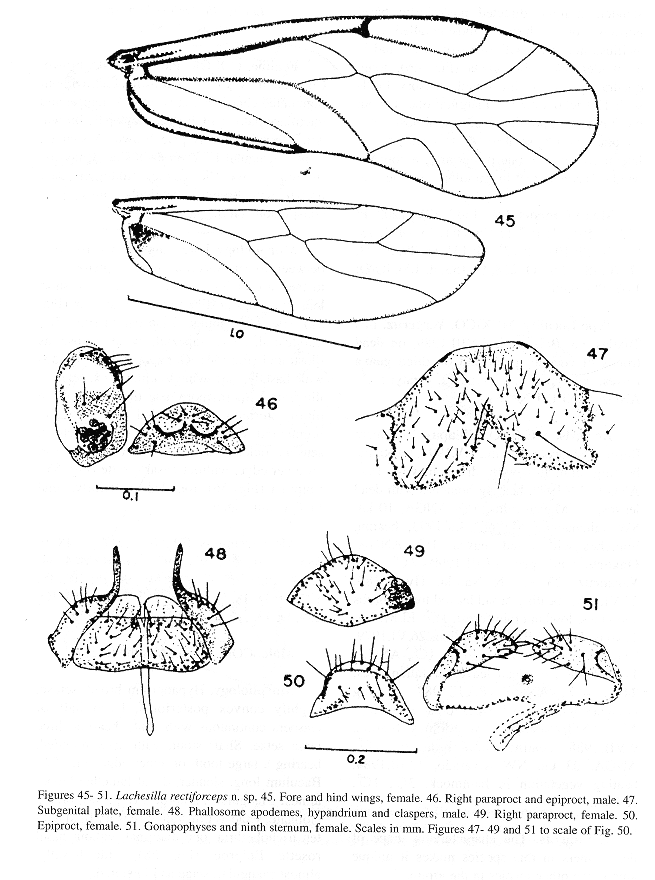Revista de Biología Tropical
versão On-line ISSN 0034-7744versão impressa ISSN 0034-7744
Rev. biol. trop vol.47 no.1-2 San José Jun. 1999
New North American Lachesilla in the Forcepeta
group (Psocoptera: Lachesillidae)
Alfonso Neri García Aldrete 1
Received 12-I-1998. Cerrected 7-IX-1998.Accepted 19-X-1998.
Abstract
Ten species of Lachesilla, belonging in species group Forcepeta, are here described and ilustrated; three of them occur exclusively in the United States, six are exclusive to México and one occurs mostly in Mexico, extending also to Guatemala. They differ among themselves, and are separated from other species in the group, mostly on genital characters. The location of the types is indicated in each description.
Key words
Lachesilla, Forcepeta group, new species, U.S.A., Mexico.
Lachesilla is one of the most speciose psocid genera, in which, to the present , some 360 species can be recognized, represent in the National Insect Collection (Instituto de Biología, UNAM., Mexico City, and in the E.L. Mockford´s Collection (Illinois State University, Normal, Illinois). Of those, 204 species have been described and 156 are new to science. In such a large assemblage of species, distributed worldwide, 15 species groups have been phenetically recognized, these are the groups Andra, Centralis, Corona, Forcepeta, Fuscipalpis, Intermedia, Magnifica, Mexica, Palmicola, Patzunensis, Pedicularia, Q., Riegeli, Rufa and Texcocana. A phylogenetic study of the genus remains to be attempted, although Mockford (unpublished), utilizing Nadleria Badonnel & García Aldrete (1979) as outgroup, presented a proposal, based on genital and paragenital characters of males, that recognizes five lines, three of which include exclusively Pedicularia group species, one line includes 11 groups of species,and another one includes species in the gropus Andra, Forcepeta, Intermedia and Pedicularia.
The group Forcepeta is a large assemblage of 102 species, most of them undescribed, morphologically well defined within the genus, than occur in the Neotropical (85 species), Nearctic (13 species), and Ethiopian (seven species) regions. The group was recognized and diagnosed by García Aldrete (1974, in press) and Mockford (1993), included it in a key to the North Amercian subfamiles, genera and species of the family Lachesillidae. A brief diagnosis, based on genital characters, follows:
FEMALE. Subgenital simple, without a median tongue or process, with posterolateral shoulders or short processes. Ninth sternum usually without pair of short projections on anterior margin. Ovipositor valvulae broad, round or blunt tipped, directed mesally.
MALE. Phallosome apodemes fused to form a single rod or baculum, branching once distally into a pair of rounded or triangular membranous extensions. Claspers lateral to hypandrium, with proximal and distal ends distinct, well defined, moderately long, frequently recurved, not approaching midline. Paraproct without process or extremely short one.
In this paper, I present descriptions of ten species that occur in the United States (three species), and in Mexico (seven species).
Materials and Methods
The material studied consists of 720 specimens, preserved in 80% alcohol, or dissected and mounted on slides, either in Euparal or in Balsam of Canada. Color was recorded by examination of the specimen in 80% alcohol, under a dissecting microscope at 100X. Standard measurements (FW = righ fore wing length, HW = righ hind wing length, F= hind femur length, T= hind tibia length, t1, t2 = lengths of hind tarsomeres 1 and 2, cct1 = number of ctenidia on t1, Mx4 = length of fourth segment of maxillary palp, f1...fn= length of flagellomeres 1...n, Io = minimum distance between compound eyes, D = antero-posterior diamentes of compound eye, d = transverse diameter of compound eye, PO = d/D) are given in microns, and were taken from parts mounted on slides, under the compound microscope, utilizing a filar micrometer whose measuring unit is 1.36 microns for wings and 0.53 microns for other parts. The scales of the illustrations are in mm.
The names of the collectors are abbreviated as follows: AC, Alex Cadena; AMN, Aaron M. Nadler; ANGA, Alfonso N. García Aldrete; CWOB, Charles W. O´Brien; EB, Ernesto Barrera; ELM, Edward L Mockford; GBM, George B. Marshall; GEE, Gary E. Eertmoed; GO, Guillermina Ortega; HB; Harry Brailovsky; JAC, J. Arturo Casassola; JL, Joe López; LBM, Leticia B. Menchaca; LBOB, Lois B. O¨Brien; LC, Luis Cervantes; OR, Omar Rilett; RC, Rodamond Coates and RS, Ron Sloan.
The types are deposited in the National Insect Collection Instituto de Biología, UNAM; Mexico City (CNI-IBUNAM), or in the E.L. Mockford Collection, housed in the Departament of Biological Sciences, Illinois State University, Normal, IL (ISU).
(Figs. 1-6)
Female. Color. Body dark reddish brown. Compound eyes black, ocelli hyaline, without pigmented centripetal crescents. Two dark brown bands from each compound eye to epistomal sulcus, enclosing antennal fossae. Maxillary palps dark brown. Antennae and legs brown. Wings opaque, fumose, veins reddish brown. Abdomen with reddish brown subcuticular rings, less pigmented ventrally.
Morphology. Forewing (Fig. 1) with pterostigma almost rectangular, R1 deeply pigmented. Rs-M fused basally for a short length. Hind wing (Fig.1) with Rs-M joined basally for a length. Subgenital plate (Fig. 5) broad, straigth posteriorly, with a long, slender, pigmented band, diagonal on each postero-lateral corner. Gonapophyses (Fig. 4), large, robust, setose as illustrated. Spermapore small, surrounded by a slender, pigmented band, diagonally on each postero-lateral corner. Gonapophyses (Fig. 4), large, robust, setose as ilustrated. Spermapore small, surrounded by a slender, pigmented ring, slightly towards anterior border of ninth sternum. Paraprocts (Fig.3) large, almost elliptic, setose as illustrated;sensory fields with 10 trichobothria, a marginal one without basal rosette, distal half of paraproct distinctly less pigmented than proximal one, bearing the sensory field. Epiproct (Fig. 3) trapecial, setal field on posterior half, as illustrated.
Measurements. FW: 1906, HW: 1470, F: 382, T: 754, tl: 223, t2: 75, ctt1: 18, Mx4: 84, f1: 247, f2: 200. F3: 172, f4: 119, f5: 80, f6: 72, f7: 61, f8: 64, f9: 58, f10: 55, f11: 66, IO:289, D: 152, d:106, IO/D: 1.89, Po: 0.69.
Male. COLOR. Same as the female.
Morphology. Hypandrium (Fig.6) deeply concave posterirly, with a strongly pigmented
band along posterior border; setae as illustrated. Phallosome apodemes fused to form a long, stout baculum (Fig.6), wider posteriorly and divided posteriorly, each arm forming a basally wide, curved prong, bearing on inner side a small, denticulate extension. Claspers (Fig.6) with short, rounded, proximal portion, bearing two large setae, and long, acuminate shaft, bearing mesally a long, denticulate ridge, that ends much before the apex of the shaft, as illustrated. Paraprocts (Fig.2) broad, setose, mesally with a lightly pigmented area; sensory fields with 11 trichobothiria, a marginal one without basal rosette. Epiproct (Fig.2) strongly pigmented, anterior margin flat, with a stout, pointed extension posteriorly, and an elongate, mesal, less pigmented area. Setae as illustrated.
Measurements. FW: 1713, HW: 1326, F:371, T:708, t1:258, t2: 137, cct1: 17, Mx4: 86, f1: 240, f2: 212, f3: 200, f4: 141, f5: 98, f6: 83, f7: 76, f8: 70, f9: 76, f10: 66, f11: 79, IO: 248, D: 154, d: 108, IO/D: 1.61, PO: 0.70.
Type Locality. México. Chiapas. 4 Km S Simojovel, 880 m., 13.VIII.1975, on dead, hanging leaves of herbaceous plants, ANGA, holotype , allotype
, paratypes
11 paratypes
(CNI-IBUNAM).
Records. MEXICO. Campeche. Km. 178 Hwy. Escárcega-Chetumal, 23.VI.1989, beating vegetation, LC & AC, 1 . Calakmul Biosphere Reserve, Hormiguero Archaeologial Zone, 6. V.1997, beating shrubs, ANGA, 2
, 2
. EJIDO Colón, 7.V.1997, beating herbaceous plants with dead leaves. JAC, 3
. Chiapas. 4 Km N Tuxtla Gutiérrez, 15.VII.1962, beating vegetation on secondary growth forest, edge of Sumidero Canyon. ELM, 1
. Chinkultik Archaeological Zone, 51 Km SE Comitán, 1,500 m., 11.VIII.1975, on dead haning leaves of Compositae, ANGA, 1
. 2 Km S Ixtapa, Hwy. 195, 1,100 m., 12.VIII.1975, on dead banana fronds, ANGA, 1
. 42 Km NW Ocozocoautla, 1.VII.1981, beating branches with dead leaves of fallen shrubs, forest edge, ANGA, 1
. El Ocote Biophere Reserve, 700 m., 1.V.1993, beating branches with dead leaves, ANGA & EB, 1
. Hidalgo. Omitlán, ca. Real del Monte, Hwy. 105, 21. VIII.1980, beating oaks, ANGA, 1
. Morelos. Ticumán, 17.X.1971, on dead handing leaves of Compositae, ANGA, 1
, 1
. Oaxaca. Toltepec. 1.XI. 1987, EB, 1
. Km 16, Rd. Jalapa de Díaz - Tuxtepec, 18.III.1989, beating vegetation, LC & AC, 1
. Km 5, Rd. Mogoñe –San Juan Guichicovi, 70 m., 22.XI.1990, EB, 1
. San Luis Potosí. 6 Km N Tamazunchale, 25-II.1973, on dead leaves of miscelaneous vegetation on mountain slope, ANGA, 1
. 20 Km N Jct. Hwy. 85 and Rd to Xilitla, ca. Tamuín. 25.II.1973, on dead leaves of Convolvulaceae, ANGA, 3
. Tabasco. Villahermosa, Agua Blanca, 17.VI.1989, beating vegetation, LC & AC, 1
. Tamaulipas. 1.6 Km S Rd. To Xicoténcatl, on Hwy. 85, 30.III.1961, beating cattails, ELM, 1
, 1
. Veracruz. 8 Km S Tecolutla, 26.VI.1962, ELM, 1
. 3 Km N Santiago Tuxtla, Hwy. 180, 9.VII.1962, beating vegetation, upland rain forest, ELM, 1
. Rd. To Cerro El Vigía, ca. Santiago Tuxtla, 12.VII.1973, beating branches with dead leaves in forest ANGA, 1
. 6 Km NE San Andrés Tuxtla, rd. to San Martín Volcano, 15.VII.1973, beating vegetation, semi-arid scrub on lava flow, ANGA, 1
. Ca. Tuxpan, 2.VIII.1978, on dead, handing leaves of herbaceous plants, N edge of Tuxpan River, ANGA, 1
, 6
.
Lachesilla carinatoides n. sp.
(Figs. 7-12)
Female. COLOR. Body reddish brown. Compound eyes black, ocelli hyaline, without pigmented centripetal crecents. Two dark brown bands from each compound eye to epistomal sulcus, enclosing antennal fossae. Maxillary palps and antennae dark brown. Wings slightly fumose, veins reddish brown. Stigmasac and R1 of fore wing ochre. Legs pale brown. Abdomen with reddish brown subcuticular rings, less pigmented ventrally.
Morphology. Fore wing pterostigma (Fig.7) about 3.5 times as long as wide in the middle, R1 wide. Rs-M diverging from a point, areola postica wide basally, almost triangular. Hind wing with Rs-M diverging from a point (Fig.7). Subgenital plate narrow (Fig.11), setae as illustrated, with one slender pigmented band diagonally on each postero-lateral corner. Gonapophyses (Fig. 10) very robust, setose. Spermapore (Fig.10) towards anterior border of ninth sternum, surrounded by a slender, pigmented ring. Paraprocts semi-elliptic (Fig. 9), setae as illustrated; sensory fields with 10-11 trichobothria, a marginal one without basal rossette Epiproct (Fig.9) almost trapezial, setae as illustrated.
Measurements. FW: 1705, HW: 1297, F: 347, T: 689, t1: 222, t2: 85, cct1: 19, Mx4: 71, f1: 220, f2: 167, f3: 160, f4: 113, f5: 62, f6: 66, f7: 64, f8: 62, f9: 61, f10: 57, f11: 76, IO: 271, D: 138, IO/D: 1.9, PO: 0.68.
Male. COLOR. Same as the female.
Morphology. Hypandrium (Fig.12), deeply concave posteriorly, with a strongly pigmented band along posterior border. Phallosome apodemes fused to from a long, stout, baculum (Fig.12), divided posteriorly, each arm forming a basally wide, stout, curved prong, bearing on inner side a wide extension limited posteriorly by a row of 6-7 posterior denticles. Claspers (Fig. 12), basally rounded, elongate; shaft long, slender, acuminate, with two basal large setae, and bearing a long, denticulate ridge from anterior end to the apex. Paraprocts (Fig. 8), robust, almost semicircular, setae as illustrated, mesally with a clear, elongate area; sensory fields with 11-12 trichobothria, a marginal one without basal rosette. Epiproct (Fig.8), with hind margin flat, with a process directed posteriorly from te hind margin, mesally with a transverse, almost rectangular pale area; setae as illustrated.
Measurements. FW:1762, HW: 1346, F: 363, T: 693, t1: 243, t2: 87, ctt1 20, Mx4: 94, f1: 239, f2: 220, f3: 201, f4: 156, f5: 98, f6: 84,f7: 78, f8: 73, f9: 69, f10: 66, IO: 267, D: 166, d: 105, IO/D:1.6, PO:0.63.
Type Locality. MEXICO. Nayarit. María Madre Island, rd. from Port Balleto to LA Antena, 210 m., 226.III.1984, beating branches in low deciduos forest, ANGA, holotype , allotype
, one paratype of each sex (CNI-IBUNAM).
Records. MEXICO. Guerrero. 22 Km SW Carrizal de Bravo, rd. Milpillas-Atoyac, 5.II.1974, beating shrubs, ANGA, 1 . Oaxaca. 20 Km NW Pochutla, 9.III.1995, beating vegetation, GO, 1
.
Comments. This species presumably constitutes the sister species of L. carinata. This assertion is based on a male synapomorphous character: presence of a denticulate ridge on the clasper shaft, relatively short in L. carinata, and distinctly longer in L. carinatoides. Other differences are the narrow denticulate lamellae of the distal prongs of the phallosome apodemes and relatively broader sudgenital plate in L. carinata, as compared to the distinctly wider lamellae of the distal prongs of the phallosome apodemes, and narrower subgenital plate in L. carinatoides.
L. carinata is much more widely distributed than L. carinatoides, this being restricted to María Madre Island and two points near the Pacific coast, in the states of Guerrero and Oaxaca. The two species are allopatric.
Lachesilla cladiumicola n. sp.( )
(Figs. 13-17)
Color. Body light brown. Compound eyes black, ocelli clear, without pigmented centripetal crescents. A reddish brown band from each compound eye to epistomal sulcus, enclosing antennal fossae. Antennae and maxillary palps light brown. Legs light brown. Wings hyaline, veins brown. A slender, brown band on each side of thorax, running above the coxae, abdomen with brown subcuticular rings, more conspicuous on the sides.
Morphology. Fore wings (Fig.13) small, narrow, with crossvein from lower posterior angle of pterostigma to R2+3, Rs-M diverging from a point. Areola postica anomalous, incomplete (Fig.13). HW with Rs-M fused for a lengh. Sudgenital plate (Fig.16), broad, setose, almost trapezial, with distinctly prominent postero-lateral corners and a trinagular, sclerotized prominence next to each corner. Gonapophyses wide based, narrowing to blunt apex, setose as illustrated (Fig.15). spermapore round, almost in center o of ninth sternum, surrounded by a wide, pigmented ring. Paraprocts (Fig.17) almost semi circular, sensory fields with eight trichobothria, one without basal rosette, epiproct (Fig.14) trapezial, setal field on posterior half.
Measurements. FW: 1400, F: 401, T: 562, t1: 179, t2:77, ctt1: 9, Mx4: 76, f1: 256, f2: 244, f3: 194, f4: 145, f5: 92, f6: 88, f7: 77, f8: 77, f9: 72, f10: 72, f11: 76, IO: 285, D: 150, d: 106, IO/D: 1.89, PO: 0.70.
Type Locality. U.S.A. Florida. Levy Co., East side of causeway to Cedar Key, 12.IIIV.1965, on dried sawgrass leaves, holotye , ELM (ISU).
Comments. This species is close to L. typhicola n.sp., which it shares the crossvein between the pterostigma and R2+3. It differs from it in its smaller size, and in the subgenital plate, lacking pointed protuberances in L. typhicola.
Lachesilla estradaorum n.sp.
(Figs.18-23)
Female. COLOR. Boby reddish brown. Compound eyes black, ocelli hyaline, without centripetal pigmented crescents. Maxillary palps, antennae and legs brown. Abdomen with reddish brown subcuticular rings, less pigmented ventrally.
Morphology. Fore wing (Fig.18), with pterostigma about three times as long as wide in the middle. Rs-M diverging from a point. Areola postica low, wide basally, about two times as wide as tall. Himd wing (Fig.18) with Rs-m basally fused for a length. Subgenital plate (Fig.20), broad, setose, with, distinct, prominent, rounded postero-lateral corners, hind marging almost flat, bordered by a hyaline band. Gonapophyses (fig.22), widest in the middle, narrowing to apex, setae as illustrated. Spermapore (Fig.22), large, almost in the center of ninth sternum, with a wide, irregular ring surrounding it. Paraprocts, (Fig.23), semi-elliptic, setae as illustrated, sensory fields with 9-10 trichobothria, a marginal one without basal rosette. Epiproct (Fig.23), wide, setae as illustrated.
Measurements. FW: 1516, HW: 1180, F: 318, T: 552, t1: 178, t2: 71, ctt1: 15, Mx4:72, f1:212, f2:169, f3:155, f4:113, f5:68, f6:73, f7:58, f8:61, f9:60, f10:61, f11:61, IO:265, D:150, d:95, IO/D:1.76, PO:0.63.
Male. COLOR. Same as the female.
Morphology. Hypandrium wide transversely, narrow antero-posteriorly (Fig. 21). Phallosome apodemes fused to form a slender rd or baculum, membranous extensions of each distal arm contiguous. Basal portion of claspers (Fig. 21) almost rectangular, each with two large setae ans 3-5 additional, smaller ones, shafts curved, very stout, with the apices dilated. Paraprocts (Fig.19), large, semi-elliptic, setae as illustrated, with a small mesal prominence, sensory fields with 10-11 trichobothria, a marginal one without basal rosette. Epiproct (Fig.19)., large, with anterior margin nearly flat, rounded posteriorly, setae as illustrated.
Measurements. FW:1426, HW:1076, F: 303, T:546, t1:180, t2:70,ctt1:16, Mx4:81, f1:200, f2:167, f3:153, f4:123, f5:90, f6.80, f7:74, f8:71,f9:71, f10:69, f11:85, IO:252, D:150, d:101, IO/D:1.67, PO:0.66.
Type Locality. MEXICO. Veracruz. Los Tuxtlas, UNAM Biology Station. 8.VII. 1988, beating branches with dead leaves in forest, ANGA, holotype, allotype
, (CNI-IBUNAM).
Comments. This species is similar to L. cuala García Aldrete (1988), widely distributed from Mexico to South America, and to several others, undescribed South American species, from which it differs mostly by the prominent postero-lateral corners of the subgenital plate, and by the stout clasper shafts, unique among the species of the group.
Lachesilla filicicola n. sp. ()
(Figs. 24-26)
Male. COLOR. Brown. Compound eyes black, ocelli hyaline, with ochre centripetal crescents. Maxillary palps and antennae brown. Legs pale brown. Wings hyaline, veins brown. Thoracic pleurae with a reddish brown band above the coxae. Abdomen with reddish brown subcuticular rings, less pigmented ventrally.
Morphology. Fore wing (Fig.24). hypandrium (Fig.25), narrow antero-posteriorly, slightly concave posteriorly. Phallosome apodemes fused to from a short, stout rod or baculum (Fig.25), with distal membranous extensions very large. Claspers (Fig. 25), with shafts curved, apically dilated; basal portions robust, wider posteriorly, each with two large setae and 7-10 smaller setae, as illustrated. Paraprocts (Fig.26), almost elliptic, with setae as illustrated and sensory field with 14 trichobothria, a marginal one without basal rosette. Epiproct (Fig. 26), wide, concave anteriorly, rounded posteriorly; setae as illustrated.
Measurements. FW:2189, F:472, T:832, t1:299, t2:94, ctt1:22, Mx4:106, f1:311, f2:162, f3:133.
Type Locality. MEXICO. Tabasco. Río Tonalá & Hwy. 180, 17.III.1964, beating dried fern leaves, ELM, 1 holotype (CNI-IBUNAM).
Comments. This species is unique in the group by having large, stout basal portions of the claspers, with short, curved, apically dilated shafts. The extremely large, distalextensions of the baculum are also unique in the group. Several undescribed Central and South American species also have apically dilated clasper shafts.
Lachesilla floridana n.sp.
(Figs. 27-32)
Female. COLOR. Pale brown. Compound eyes black, ocelli hyaline, with ochere centripetal crescents. Two brown bands from each compound eye to epistomal sulcus, enclosing antennal fossae. Antennae and maxillary palps ligh brown. Legs pale brown. Wings hyaline, veins brown. A brown band on each side of thorax, running above coxae. Abdomen with ochre sudcuticular rings, more conspicuous laterally.
Morphology. Fore wings (Fig.27), slender, with a crossvein from the lower posterior angle of pterostigma to Rs, before junction of R2+3.- R4+5 (some specimens with crossvein between pterostigma and proximal end of R2+3). Rs-M joined basally for a length (Fig.27). areola postica wide basally, almost triangular. Hind wing Rs-m joined basally for a length (Fig.27). subgenital plate (Fig. 29), broad, sètose,posteriorly straight. Gonapophyses (Fig.28) narrowing distally to blunt apices. Ninth sternum with two semi-circular pigmented areas posteriorly (Fig.28). spermapore towards anterior border of ninth sternum surrounded by an elliptic, pigmented area (Fig.28). apraprocts (Fig 30) broad, elogante, setose as illustrated, sensory fields with 9-10 trichobothria, one without basal rosette. Epiproct (Fig. 30), almost trapezial, wide basally, posteriorly rounded; setal field on distal half.
Measurements. FW:1733, HW:1327, F344, T: 614, t1:187, t2:85, ctt1:11, Mx4:74, f1:265, f2:242, f3:207, f4:143, f5:88, f6:80, f7:68, f8:73, f9:64, f10:73, f11:81, IO:265, D:137, d:117, IO/D:1.93, PO:0.86.
Male. COLOR. Same as the female.
Morphology. Hypandrium wide, posteriorly concave (Fig. 31), claspers with three setae on distal end of short basal portion (Fig. 31). Clasper shafts stout, curved, distally dilated as illustrated (Fig.31), phallosome apodemes fused to form a long baculum, distally with two pointed prongs and two broad lamellae with outer edge jagged, in addition to the two broad membranous extensions (Fig.31). paraprocts (Fig.32), almost elliptical, setose as illustrated, sensory fields with 9-10 trichobothria, a marginal one without basal rosette. Epiproct (Fig. 32), with anterior margin flat, rounded posteriorly, setae as illustrated.
Measurements. FW:1556, HW:1175, F:286, T:540, t1:172, ctt1:11, Mx4:70, f1:248, f2:232, f3:201, f4:162, f5:106, f6:95, f7:86, f8 :88, f9:90, f10:84, f11:108, IO:232, D:132, d:106, IO/D:1.76, PO:0.80.
Type Locality. USA. Florida. Collier Co., State Hwy. 846, ca. 2mi.W Hwy. 41, between Bonita Springs and Naples, 29.XI.1970, beating vegetation (dried palm fronds, pine branches, etc.), holotype, allotype
, 10
and 7
paratypes (ISU), ELM.
Records. USA. Florida. Okaloosa Co., 17 mi. E Niceville, 22.VIII.1951, 1 , 1
, ELM. Monroe Co., Lower Matecumbe Key, 29. VIII.1951, 2
, 1
, ELM. Big pine Key,28-29.VIII.1951, beating Pinus caribbea, 1
, ELM. 16.II.1954, on dry palm fronds, 7
, 5
, ELM. 21.II.1956, beating silver palm leaves, 6
, 4
, ELM. Marathon, 16.II.1954, on dead palm fronds, 2
, ELM. Highlands Co., Lake Placid, Archbold Biological Station, 7.II.1951, 3
, AMN, Polk Co., 2 mi. N Lake Wales on US Hwy. 27, 25.XI.1961, beating dead, saw palmetto leaves, 6
, ELM & OR. Taylor Co., at Taylor-Dixie county line on US Hwy. 24.XI.1961, beating Sabal palmetto and Serenoa repens dry leaves, 6
, ELM & OR. Taylor Co., at Taylor-Dixie county line on US Hwy. 24:XI.1961, beating Sabal palmetto and Serenoa repents dry leaves, 1
, 1
, ELM. Manatee Co., US Hwy. 301, 3 min. S Parrish, 4.XII. 1970, beating Serenoa repens, 4
, 5
, ELM. Marion Co., on road between Sparr and Kerr City, Ocala National Forest, 19.III. 1953, beating dry saw palmetto leaves, 1
, 1
, ELM. Levy Co., E side of causeway to Cedar Key, 12.IV.1965, on dried sawgrass leaves, 1
, ELM. Palm Beach Co., Hwy. 441, 8 min. S Hwy. 98, Jct. (to Palm Beach) 3.XII. 1970, beating Serenoa plam with blue pruinosity, 7
, 3
, ELM. Hernando Co. Bayport 28. XI. 1970, beating dried fronds of Serenoa repens, 9
, 7
,ELM. Alachua Co., I mi. W Newnan`s Lake, on road from Gainesville, 20. VIII. 1952,in dried saw palmetto leaves,1
, 1
, ELM. Hendry Co., La Belle, 4.II.1953, on small bromeliad on oak in hammock, 1
, 1
, ELM.
Comments. The pigmented areas of the fenale ninth sternum, and the apices of the clasper shafts, make this species unique in the species group. The acuminate distal extensions of the baculum, and its denticulate projections, are similar to the corresponding structures of the males of L. caranita and L. carinatoides.
Lachesilla laciniosiforceps n. sp.
(Figs. 33-38)
Femela. COLOR. Light yellowish brown. Compound eyes black, ocellii hyaline, without centripetal crescents. Two brown bands from each compound eye to epistomal sulcus, enclosing antennal fossae. Antennae and legs pale brown. A brown, irregular band on each side of thorax, above the coxae. Wings hyaline, veins brown. Abdomen with reddish brown subcuticular rings, more conspucuous dorsally.
Morphology. Fore wing (Fig.33), with pterostigma elongate, almost rectangular; Rs-M diverging from a point; areola postica almost triangular. Himd wing (Fig. 33), with Rs-M fused basally for a short length. Subgenital plate (Fig.36), broad, setae as illustrated, postero-lateral corners rounded; one elongate pigmented area on each side of longitudinal midline. Gonapophyses (Fig. 38), widest in the middle and narrowing to both ends, blunt distally, setae as illustrated. Spermapore small, towards anterior border of ninth sternum, surrounded by wide, pigmented band in the middle. Paraprocts (Fig. 35), semi-elliptic, setae as illustrated, sensory fields with 12 trichobothria set on basal rosettes, except a marginal one. Epiproct (Fig.35), almost semi-circular, setal field on posterior half.
Measurements. FW: 2524, HW:1935, F: 492, T:909, t1:321, t2:98,ctt1:19, Mx4.107, f1:348, f2:298, f3:229, f4:176, f5:110, f6:102, f7:91, f8:82, f9:74, f10:73, f11:103,IO:319, D:180,d:131, IO/D:1.77, PO:0.72.
Type Locality. MEXICO. Chiapas. Parque Nacional Lagunas de Montebello, 60 Km SE Comitán, 1,500 m., 11.VIII.1975, beating brnaches with dead leaves of fallen tree, ANGA, holotype Ó paratypes (CNI-IBUNAM).
Records. USA. Florida. Sarasota Co., Myakka Park, 12.IV.1952, 1 ,
1
, ELM. Monroe Co., Big Pine
Key, 21.II.1956, 1
, ELM.
Louisiana. New Orleans, Audubon Park, 1:XII.1965, beating vegetation, 2
,1
,
ELM. MEXICO. Coahuila. Zaragoza, 23.VIII.1970, on dead leaves of Fraxinus sp. 1
, ANGA. Chiapas.
5 Km N Ocozocoaula, on rd. To Malpaso, 1.VII.1981, beating oak branches with dead leaves, 3
, 1
, ANGA, LBM. Nachig, 15 Km W San Cristóbal de las Casas, 2.VII.1981, beating branches of Cupressus, 1
,
ANGA. 46 Km SW San Cristóbal de las Casas, Hwy, 190, 1,100 m., 10.VII.1975, beating oaks, 2
, 4
,
ANGA. 45 Km E Tuxtla Gutiérrez, Hwy, 190, 15.VII.1962, beating vegetation, ELM. Lagunas de Mntebello , 3.VII.1981 beating Liquidambar, 2
,
ANGA. 10 Km NE Comitán, 2.VII.1981, beating oaks and miscellaneous shrubs, 4
, ANGA. 6 Km Rd,
to Pueblo Nuevo, 53 Km N Hwy, 190, 17.VII.1962, 1
,
1
, ELM, 40 Km N Hwy.190,
17.VII.1962, beating oaks and pines, 2
,
1
, ELM. 14 Km N Tuxtla Gutiérrez,
14. VII.1962, 2
, 1
,
ELM, 46 Km SW San Cristóbal de las Casas Hwy. 190, 1,100 m., 10.VIII.1975, beating brnaches with dead leaves of mango, 3
,
2
, ANGA. 2 Km S Ixtapa, Hwy.
195, 10 Km N Juction with Hwy. 190, 1,100 m., 12.VIII.1975, beating dry banana leaves and shrubs, 2
,
2
, ANGA. 5 Km N Ocozocoautla,
rd. To Malpaso, 1.VII.1981, beating oak branches with dry leaves, 1
,
1
. ANGA. 26 Km E Tapanatepec,
Oaxaca, Hwy. 190, 12. VII.1962, 1
ELM. Guerrero. 94 Km N Acapulco, 29.VII.1969, beating oak branches with dry leaves, 2
, ANGA.
Hidalgo, Omitlán, ca. Real del Monte, Hwy. 105, 21.VII.1980, beating oaks, 2
, 4
,
ANGA. 16 Km S Jacala, Hwy. 85, 23.VI.1962, beating broad leaved tress and shrubs, 1
, 1
, ELM. 18 Km NE Rancho Viejo, Hwy. 85, 22.VI.1962, 36
,
20
, ELM. 38 Km NE Rancho
Viejo, Hwy. 85, 22.VI.1962, beating vegetation in forest, mostly oaks, 2
, 3
,
ELM. 35 Km E Pachuca, Hwy. 130, 24.VI.1962, sifting ground litter, 1
, 1
, ELM, Jalisco.
Ca. El Tuito, Rd. to El Cuale, 890 m., 18.IX.1988, on boulder covered with lichens, 1
, ANGA. Nuevo
León. Guadalupe, Rancho Alamillos, NE, slope Cerro de la Silla, 600 m.,13.VIII.1972, on dried hanging leaves of Sechium, edule, 1
,
1
, ANGA, 20.VIII.1978, beating
vegetation, 3 Ó, 5 Ó, ANGA, 27.VIII.1978, beating branches with dead leaves of vegetation, including Quercus, Musa and Ruteceae, 2
,
1
, ANGA, 22.XII.1978, beating
vegetation, 4
, 1
,
ANGA. 31.VII.1979, beating branches of miscellaneous trees, 2
,
ANGA. 11.IV.1976, beating branches with dead leaves of avocado trees, Quercus and shrubs 25
, 20
,
ANGA. 31.VII.1979, beating branches branches of trees, 1, ANGA. 22.X.1978, on dead banana leaves, 9
,
3
, ANGA. 26.VIII.1984,
beating pear trees and miscellaneuous shrubs, 1
,1
,
ANGA. 23.VII 1979, sifting oak litter, 1
,
ANGA. 23.VIII.1981, beating Quercus and miscellaneous shrubs, 2
, 1
, ANGA. 17.IV.1982, beating
vegetation with dried leaves 3
,
2
, under loose bark of tree trunk,
1
, ANGA. 30.III.1988,
beating vegetation, 1
, ANGA.
22.V.1967, beating vegetation, 2 Ó, 4 Ó, ANGA. Ca. Monterrey, W slope Cerro de la Silla, Col. Contry, 22. V.1975, on dead Dasylirion inflorescence, 1
, ANGA.
Trail to N Peak, beating vegetation, 300 m., 18.IX.1977, 5
,
4
, sifting litter, 1
,
ANAG. Trail to the Arch, 900 m., 28.VIII.1982, beating vegetation, thory scrub, 2
, 1
, ANGA. 12.VIII.1982, beating vegetation, throny scrub, 2
,
1
, ANGA.12.VIII.1989, 800
m., beating vegetation, 1
,
1
, ANGA. 16 Km E Iturbide, Hwy.
60, 13.VI.1962, beating cycads on hillside, 3
,
beating vegetation, 1
, 1
,
ELM. Santiago Horsetail Fall, 14.IX.1963, beating branches with dry leaves at park entrance, 2
, 2
,
ELM. 21:VIII.1978, beating vegetation, 10
,
4
, ANGA, 18.VII.1980, on dried
leaves of broad leaved trees, 1
,
ANGA. La Boca Dam, 27.XII.1973, beating vegetation on mountain slope, 3
,
ANGA. 4.IV.1988, beating Cyperus and Senecio, stream edge, 1
,
2
, ANGA. Santiago, 3 Km N
El Alamo, 23.II.1977, on dried Seloa and banana leaves, 2
,
ANGA. Ca. Santiago, El Carrito, 30.VIII.1985, on dried leaves of Convolvulaceae vine, 1
, ANGA. 26 Km SW
Linares 680m., Hwy.60 Santa Rosa Canyon, 24.VIII.1975, beating oaks, 13
,
5
, ANGA. 11 Km. W La Ciénega,
towards Laguna de Sánchez, 18.VII.1980, on dried leaves of broad leaves of broad leaved trees, 1
,
ANGA. La Boca Dam, 27.XII.1973, beating vegetation on mountain slope, 3
,
ANGA. 4.IV.1988, beating Cyperus and Senecio, stream edge, 1
,
2
, ABGA. Santiago, 3 Km N
El Alamo, 23.II.1977, on dried Seloa and banana leaves, 2
,
ANGA. Ca. Santiago, El Cerroto, 30.VIII. 1985, on dried leaves of Convolvulaceae vine, 1
, ANGA. 26 Km SW
Linares, 680 m., Hwy. 60 Santa Rosa Canyon, 424.VIII:1975, beating oaks, 13
, 5
,
ANGA. 11 km. W la Ciénega, towards Laguna de Sánchez, 18.VII.1980, on dried leaves of broad leaves trees, 1
,
Ana. 9 Km. SE Monterrey, 12.VI.1962, beating oaks, 1
,
1
, ELM. Garza García,
28.XII.1969, beting hanging dry banana leaves, 2
,
2
, ANGA. 17 Km S La Ascención,
Hwy. NL-63, 1, 900 m., 24.VIII.1975, beating oaks and shrubs, 3
,
1
, ANGA. 8 Km N Allende, 650m.,
23.II.1977, beating herbaceous plants, stream edge, 1
,
1
, ANGA. Lazarillos, ca.
Allende 370m., 30.VIII.1985, on dead leaves of Salix, 2
,
1
, ANGA. 3 Km SE Aramberri, 1,000
M., 12.XI.1976, beating branches with dead leaves of avocado trees and shrubs, 5
, 6
,
ANGA. 9 Km S Villaldama, 440 m., 27.V.1976, beating branches with dead leaves of Ehretia elliptica, 3
,
ANGA. El Encadenado Creek, 29 KM N Hualahuises, 24V.1977, beating vegetation, 1
, ANGA. 32 Km nE Rayones,
640 m., 24.II.1977, beating shrubs on stream edge, 1
,
ANGA. Ca. Monterrry, Chipinque, 9.VIII.1970, beating oak branches with dried leaves and abundant lichens, 4
,
3
, ANGA. 17.V.1976, 1,200
m., beating Seloa with dead, hanging leaves, 1
,
ANGA. Rd. to Chipinque, 950m., 23.V.1976, beating oaks, 9
,
3
, ANGA. Puebla. Finca Lourdes,
La Unión, ca. Xicotepecde Juárez, 2.XI.1963, beating coffee trees, 1
, JL. Ca. Xicotepec
de Juárez, rd. to La Unión, 1,150 m., 16.X.1982, beating vegetation, 8
, 2
,
ANGA. Ca. Hotel Mi Ranchito 1,200 m., 17.X.1982, on dead, hanging Yucca leaves, 1 O, ANGA. Hwy. 130, Jct to Nuevo Necaxa, 1,300 m., 16.XI.1974, beating vegetation, 1
, ANGA,
13 Km. NE Teziutlán, Hwy. 131, 1,200 m., 11.VI1983, beating vegetation, 1
, CWOB & LBOB. San
Luis Potosí. El Salto, 13.VIII.1958, beating vegetation, 1
,
1
, ELM. 18.VI.1962, beating lemon
tree, 1
, ELM. 19.VI1962,
beating vegetation near falls, 14
,
13
, ELM. 13 Km W Naranjo,
20.VI.1962, beating palms and understory vegetation in oak forest, 6
, 10
, ELM. Tamailupas. 15
Km W Gómez Farías, 16.VI.1962, beating vegetation along road, forest edge, 1
, ELM. Veracruz.
9 Km. E Las Trancas, Hwy. 140, 29.VI.1962, beating vegetation, 3
,
ELM. 15 Km E Orizaba, Hwy. 150, 7VII.1962, 1
,
ELM. Ca. Maltrata, 1,875 m., 31.V.1976, beating oaks, 2
HB. 2Km SW Fortín, Hwy. 150, 11.VII.1973, beating dead banana leaves on mountain slope, 1
, 1
,
ANGA. Las Minas, ca. 30 Km N Perote, 6.IX.1977, beating vegetation, 3
,
HB. Yucatán. 19 Lm SE Tekax, 25.III.1964, beating dried fronds os Queen Palm, 1
, 1
,
ELM. GUATEMALA. Naciones unidas National Park, ca.. Amatitlán, 24.VIII.1968, betaing shrubs, 1
, ANGA.
13 Km NE Guatemala City, Hwy. To Puerto Barrios, 27.VIII.1968, beating oaks, 1
, ANGA.
Comments. This species shares with L. gracilis García Aldrete , the conical extension of the epiproct, but the claspers are not apically dilated inte former, and the row of denticles extends more towards the base of the shafts; the subgenital plates and gonapohyses are distnict in both species. L. yamnomamioides Garcìa Aldrete, also has a mesal projection in the male epiproct, transverse and elongated, not conical, the clasper shafts are slender, with a row of denticles along the inner edge, and the apices are not as swollen as in L. laciniosiforceps. Also the female subgenital plate and the gonapohpyses are distinct in both species.
Lachesilla maculata n.sp.
(Figs. 39-44)
Female. COLOR. Light brown. Compound eyes black, ocelli hyaline, without pigmented centripetal crescents. Two brown bands fron each compound eye to epistomal sulcus, enclosing antennal fossae. Antemmae and legs pale brown. Wings hyaline, veins brown. Abdomen with dark brown subcuticular rings, more conspicuous ventrally.
Morphology. Pterostigma elongate, almost rectangular. Fore wing Rs-M diverging from a point; areola postica almsot triangular Hind wing Rs-M fused for a length (Fig. 39). Subgenital plate (Fig. 44), wide, extended posteriorly, setae as illustrated; one almost ciruclar, deeply pigmented area mesally on each side. Gonapophyses (Fig. 43), stout, widest in the middle, blunt ended, setae as illustrated. Spermampore small, surrounded by large, elliptic, pigmented area (Fig. 43). Paraprocts (Fig. 42), almost elliptic, sensory without basal rosette, setae as illustrated. Epiproct (fig. 42), wide basally, rounded posteriorly, setal field on posterior half.
Measurements. FW: 1653, HW: 1251, F: 312, T: 622, t1: 190, t2: 77, ctt1: 17, Mx4: 92.7, f1: 236, f2: 191, f3: 178, f4: 127, f5: 85, f6: 75, f7: 72, f8: 56, f9: 68, f10: 64, IO: 267, D: 153, d: 106, IO/D: 1.73, PO: 0.68.
Male. COLOR. Same as the female.
Morphology. Hypandrium (Fig. 41) wide, with flat anterior margin; bilobed posteriorly, each lobe terminating posteriorly as an acuminate apohysis abruptly ben laterally. Claspers (Fig. 41), slender, with one or towo setae on basal half, shaft distally blunt. Baculum (Fig. 41), stout, straight. Para procts (Fig. 40) ovoid, setae as illustated, sensory fields with 12 trichobothria, a marginal one without basal rosette. Epiproct (Fig. 40), broad, almost trapezial, with setal fields on each side, as illustrated.
Measurements. FW: 1616, HW: 1252, F: 297, T: 572, t1: 165, t2: 72, ctt1: 15, Mx4: 74, f1: 220, f2: 196, f3: 168, f4: 136, f5: 91, f6: 95, f7: 73, f8: 74, f9: 68 IO: 241, D: 175, d: 106, IO/D: 1.37, PO: 0.60.
Type Locality. MEXICO. Chiapas. Palenque Archaeological Zone, 5.VII.1996, beating foliage in rain forest, holotype 1 allotype 1
, ELM and RS (ISU).
Records. MEXICO. Chiapas. Chimalapa, 29 km N Malpaso, 8.IV.1964, beating palms in selva, 1 , ELM. Tabasco. Ejido Libertad, 2 km SW Frontera, Hwy. 180, 1.IV.1964, beating palm fronds in selva, 1
, ELM. Ejido Libertad, 6 Km. W Frotnera 27.VI.1966, beating palms in lowland rain forest, 2
, ELM. Veracruz. 13 Km N Santiago Tuxtla, 7-8VII.197, beating branches with dried leaves and dried Heliconia leaves in selva, 4
, 3
, ELM. Coyame, 9.VII.1967, beating dried banana leaves in plantation, 1
, 1
, ELM. 32 Km E Coatzacoalcos, 10.VII.1967, beating vegetation in acahual, 1
, 1
, ELM. Los Tuxtlas, UNAM Biology Station, 26.VI.1979, beating branches with dead leaves and palms in selva, 7
, 7
ANGA and ELM. 21.V.1983, beating vegetation, 1
, CWOB, LBOB, and GBM. 20.XII.1984, beating branches with dead leaves, fallen tree 5
, 1
, ANGA: 16.I.1985, beating vegetation, 1
, RC. 8.VII.1988, beating branches with dead leaves, forest edge, 3
, 1
, ANGA. BELIZE. Toledo District, Columbia, Forestry Station, ca. San Antonio 9-10.VII.1971, beating cohune palms, 5
,1
, ELM.
Comments. The slender claspers, the acuminate projections of the phallosome apodemes, and the well defined pigmented spots of the subgenital plate, make this species unique in the group.
Lachesilla rectiforceps n. sp.
(Figs. 45-51)
Female. COLOR. Pale brown. Compound eyes black ocelli hyaline, without pigmented centripetal crescents. Two brown bands from each compound eye to epistomal sulcus, enclosing antennal fossae. Maxillary palps and antennae brown. Legs pale brown. Wings hyaline, veins brown.
Morphology. Fore wing (Fig. 45), with pterostigma elongate, about four times as long as wide. Rs-M fused for a length basally, diverging from a point or connected by a shor crossvein. Areola postica wide basally, with wide, rounded apex. Hind wing (Fig. 45), with Rs-M basally fused for a length. Subgenital plate (Fig. 47), with seatae as illustrated, hind margin flat, with a hyaline band along its length. Gonapophyses (Fig. 51), widest in teh middle, blunt ended seae as illustrated. Spermapore (Fig. 51), small, almost in center of ninth sternum, surrounded by a slender pigmented rign. Paraprocts (Fig. 49), almost elliptic, setae as illustrated, sensory fields with 10 trichobothria, a marginal one without basal rosette. Epiproct (Fig. 50), almost trapezial, setal field on posterior half.
Measurements. FW: 2011, HW: 1543, F. 402, T: 732, t1; 243, t2: 89, ctt1: 19, Mx4: 98, f1: 268, f2: 235, f3: 182, f4: 147, f5: 96, f6: 86, f7: 73, f8: 82, f9: 75, f10: 68, f11: 97, IO: 265, D: 177, d: 118, IO/D: 1.49, PO: 0.66.
Male. COLOR. Same as the female.
Morphology. Hypandrium (Fig. 48), wide, setose, trapezial. Baculum (Fig. 48), long, slender, distal membranous extensions small, rounded. Claspers (Fig. 48), with shafts slender, straight, directed posteriorly; basal portions stout, with sides almost paralled, setae as illustrated, base with two large setae and 3-4 smaller ones paraprocts (Fig. 46), long, quadrate, setae as illustrated, sensory fields with 12 trichobothria, a marginal one without basal rosette. Epiproct (Fig. 46), almost semicircular, with a setal field on each anterolateral corner, and one posteriorly; a concave ban on each side of longitudinal midline.
Measurements. FW: 1537, HW: 1202, F: 323, T: 595, t1: 197, t2: 78, ctt1: 15, Mx4: 73, f1226, f2: 197, f3: 177, f4: 131, f5: 89, f6: 83, f7: 70, f8: 73.6, IO: 258, D: 153, d: 106, IO/D: 1.67, PO: 0.68.
Type Locality. MEXICO. Veracruz. Los Tuxtlas, ca. Balzapote, 3.VIII.1989 on dead fronds of coconut palm and on dried guava leaves, holotype , allotype
, paratype
, ANGA (CNI-IBUNAM).
Records. MEXICO. Chiapas. Biosphere Reserve El Ocote, 700 m., 1.V.1993, La Reina beating branches with dried leaves, 1 , ANGA. 2.V.1993 beating branches with dead leaves, ca. Mayan ruins, 1
, ANGA. 10 Km SW Jaltenango, 700 m., 4.V.1993, beating branches with dried leaves, 1
, ANGA. Oaxaca. Chiltepec, 17.III.1990, 1
, AC. Veracruz. 23 Km N Nautla, Hwy, 180, 27.VI.1962, beating broad leaved trees, shrubs and vines, lowland rain forest, 1
, ELM. Los Tuxtlas, UNAM, Biology Station, 26.VI.1979, beating foliage in forest 1
1
, ANGA. 17.VIII.1987, on dead leaves of fallen trees, 24
, 4
, ANGA. 8.VII.1988, beating branches with dried leaves, forest edge, 2
, 1
, ANGA. Ca. UNAM Biology Station 9.VII. 1988, beating citrus banches, 1
, ANGA. 23 Km NW Alvarado, 13.III.1984, beating vegetation in hammock, 3
, 1
, ANGA.
Comments. The characteristis shape of the claspers in this species makes it unique among the other species in the group.
Lachesilla typhicola n. sp.
(Figs. 52-58)
Female. COLOR. Pale yellowish brown. Compound eyes black, ocelli hyaline, without pigmented centripetal crescents. Antennae and maxillary palps pale brown. Legs pale brown, witns hyaline, veins pale brown. A slender, brown, irregular band on each side of thorax, running above the coxae. Abdomen pale brown subcuticular rings, more conspicuous on the sides.
Morphology. Fore wings with a crossvein between lower posterior angle of pterostigma to the base of R2+3. Rs-M joined for a short length; areola postica almost triangular (Fig. 52). Hw Rs-M joined for a length (Fig. 52). Subgenital plate trapezial, wide, setose as illustrated (Fig. 54). Gonapophyses (Fig. 53) wide basally, narrowing to blunt apex, setae as illustrated. Spermapore near the center of the ninth sternum, surrounded by a wide, pigmented ring. Paraprocts broad, setose, sensory fields with 10-11 trichobothria, one, on inner edge, without basal rosette (Fig. 55). Epiproct (Fig. 56), rounded posteriorly, setal field as illustrated.
Measurements. FW: 1651, HW: 1348, F: 385, T: 701, t1: 249, t2: 97, ctt1: 14, Mx4: 84, f1: 301, f2: 265, f3: 219, f4: 190, f5: 102, f6: 102, f7: 78, f8: 84, f9: 74, f10: 77, f11: 83, IO: 289, D: 138, d: 132, IO/D: 2.08, PO: 0.95.
Male. COLOR. Same as the female.
Morphology. Hypandrium broad, setose, sligntly convex posteriorly; basal half of claspers continuos with shaft, bearing three large seatae. Shaft stouf, with apex rounded, bearing a largetooth on inner edge (Fig. 57). Baculum long, slender, distal lamellae broad, almost triangular. Paraprocts (Fig. 58), broad elongate, setae as illustrated; sensory field with ten trichobothria, one marginal without basal rosette. Epiproct (Fig. 58), wide basally, almost triangular, setae as illustrated.
Measurements. FW: 1766, HW: 1345, F: 378, T: 645, t1: 212, t2: 84, ctt1: 15, Mx4: 114, f1: 300, f2: 279, f3: 226, f4: 185, f5: 107, f6: 106, f7: 78, f8: 81, f9: 76, f10: 75, f11: 93, IO: 260, D: 144, d: 106, IO/D: 1.81, PO: 0.73.
Type Locality. USA. Illinois. Lake Co. 1 mi E Waukonda, 26.VII. 1959 beating cattails, holotype , allotype
3 paratypes of each sex, ELM (ISU).
Records. USA. Illinois. Lake Co. Illinois Toll Rd. and State Rd. 176, 26.VII.1959, beating cattails, 2 , 3
, ELM. Makanda, 5.IX.1967, beating Typha latifolia, 2
, 6
, ELM. Mason Co., Mason State Forest, 23..X.1965, beating tree branches, 2
, GEE. Florida. Liberty Co., Torreya State Park, 23.VIII.1962, 3
, ELM. 3-4.VI.1952, 12
, 5
, ELM. Indiana. Steuben Co., State Rd. 120 at Fawn River, 31.VII.1956, beating cattails, 6
, 9
, ELM. Parke Co., Turkey Run State Park, 27.VI.1964, beating oaks, 2
, 8
, GEE. Michigan. Livingston Co., E.S. George Reserve, 26.VII.1956, beating dead clumps of Typha angustifolia in cattail marsh, 3
, 2
, ELM. 7.IX.1952, 10
, 9
, ELM. Minnesota. St. Paul, State Hwy. 49 at 500 Line tracs. 30.VIII.1956, beating cattails at marsh edge, 8
, 16
, ELM.
Comments. This species is very close to L. anna Sommerman, which occurs throughout eastern United States and southeastern Canada. The clasper shafts of L. anna are straight, much more slender,and the inner distal tooth is smaller than in L. typhicola. The female of the latter lacks the two yellow, ovoid sclerotized areas underlyng the subgenital plate of L. anna.
Key to the North American species of Lachesilla in the group Forcepeta
1. Fore wing with a crossvein between lower angle of pterostigma and Rs or R2+3 .................................................................... 2
1'. Fore wing without a crossvein between lower angle of pterostigma and Rs or R2+3................................................................. 4
2. Female subenital plate with postero-lateral corners pointed, slightly protruding, and with a conical projection next to each one (Fig. 16). Males unknown ......................................................................................................................... L. cladiunicola n.sp.
2`. Female subgenital plate without posterior pointed projections.............................................................................................. 3
3. Female ninth sternum with a dintinct, almost circular pigmented area on posterior margin, on each side of longitudinal midline (Fig. 30). Male claspers slightly dilated apically and slightly divided apically; phallosome apodemes posteriorly with two stout prongs, and a wide, denticulate lamella associated with each (Fig. 31) ................................................................L. floridana n.sp.
3`. Female ninth sternum not as above (Fig. 53). Claspers with a strong, acuminate projection distally on inner edge; phallosome apodemes divided posteriorly to form two almost triangular membranous pads (Fig. 57) ......................................L. typhicola n. sp.
4. Hypandrium projected posteriorly to form a long, stout, auminate extension; phallosome apodemes undivided posteriorly. Female gonapophyses broad, distally blunt, ninth sternum with a distinct, almost elliptical pigmented area posterior to spermapore, with transverse striae (García Aldrete, 1976) ............................................................................................. L. aculeata García Aldrete
4`. Hypandrium not as above. Phallosome podemes clearly divided posteriorly or extended into a membranous area. Female gonapophyses and ninth sternum not as above ...................................................................................................................... 5
5. Phallosome apodemes posteriorly extended into a broad, membranous area ..........................................................................6
5`. Phallosome apodemes posteriorly divided in two membranous pads or in two acuminate prongs ............................................ 9
6. Clasper shaft with an acuminate projection on inner edge .................................................................................................... 7
6`. Clasper shaft smooth, without projections ........................................................................................................................ 8
7. Male epiproct with well defined, stout prong posteriorly; male paraproct with small mesal prong. Female subgenital plate without pigmented areas (García Aldrete, 1996) ................................................................................... L. denticuliforceps García Aldrete
7`. Male epiproct with wide posterior projection; paraproct without mesal prong. Female subgenital plate with two mesal, well defined pigmented areas, one to each side of longitudinal midline (García Aldrete, 1988) .................... L. denticulata García Aldrete
8. Clasper shaft curved inwards distally acuminate. Female ninth sternum limited anteriorly by wide pigmented band; postero-lateral corners of subgenital plate, protruding, almost square (García Aldrete, 1988) ........................................... L. alpejia García Aldrete
8`. Clasper shaft curved outwards, distally blunt (Fig. 21). Female ninth sternum without pigmented band anteriorly (Fig. 22); postero-lateral corners of subgenital plate rounded, protrudind (Fig. 20) ....................................................... L. estradaorum n. sp.
9. Phallosome apodemes posteriorly with two distint acuminate prongs ................................................................................. 10
9`. Phallasome apodemes posteriorly with two membranous pads .......................................................................................... 13
10. Claspers slender, distally blunt; prongs of phallosome apodemes large, fused to posterior border of hypandrium, directed laterally (Fig. 41). Female subgenital plate with two mesal, rounded, distinct pigmented areas (Fig. 44) ......................... L. maculata n. sp.
10`. Claspers large, distally acuminate; prongs of phallosome not as above. Female subgenital plate withour mesal pigmented areas ................................................................................................................................................................................ 11
11, Prongs of phallosome apodemes curved inwards; clasper shaft with stout projection on outer edge, near apex. Female subgenital plate with two large, weakly pigmented areas mesally one to each side of longitudinal midline; ninth sternum with large elongate, tear-shaped, longitudinal pigmented area, enclosing spermapore (García Aldrete, 1988) ........................ L. disjuncta García Aldrete
11`. Prongs of phallosome apodemes curved outwards; clasper shaft withour projection on outer edge. Female subgenital plate and ninth sternum not as above ................................................................................................................................................. 12
12. Prongs of phallosome apodemes each with a narrow, denticulate lamella; clasper shaft with a short, denticulate carina (Fig. 6). Female subgenital plate broad (Fig. 5)................................................................................................. L. carinata García Aldrete
12`. Prongs of phallosome apodemes each with a wide, denticulate lamella, clasper shaft with a long, denticulate carina. (Fig. 12). Female subgenital plate narrow (Fig. 11)......................................................................................... L.carinatoides García Aldrete
13, Male epiproct simple, without projections or protuberances, at most with mesal field of papillae ........................................... 19
13`.Male epiproct not project posteriorly or with one or two mesal protuberances .................................................................... 14
14. Male epiproct simple, without projections or protuberances, at most with mesal field of papillae .......................................... 15
14`. Male epiproct not projected posteriorly; mesally with one or two mesal protuberances ....................................................... 16
15. Clasper shaft stout, dilated near the apex; female subgenital plate broad, posterior margin wide (Mockford & Gurney. 1956) .............................................................................................................................................. L. kathrynae Mockford & Gurney
15`. Clasper shaft slender, acuminate; female subgenital plate with sides coverging to a narrow posterior margin (Sommerman, 1946) ............................................................................................................................................. L. chapmani Sommerman
16. Clasper shaft with row of denticles on inner edge ............................................................................................................. 17
16`. Clasper shaft not as above .......................................................................................................................................... 18
17, Clasper shaft slender; male epiproct with a slender, transverse, mesal protuberance (García Aldrete, 1996) ........................................................................................................................................... L. yanomamioides García Aldrete
17`, Clasper shaft stout; male epiproct with a mesal triangular protuberance, posterior to two fieldes of papillae (García Aldrete, 1988) ................................................................................................................................................ L. gracilis García Aldrete
18. Clasper shaft slightly dilated distally, apically with 2-3 denticles on inner edge (Fig. 37); male epiproct with basally wide, mesal, triangular protuberance ........................................................................................................... L. laciniosiforceps García Aldrete
18`. Clasper shaft distally acuminate, with an acuminate projection on inner edge; male epiproct with two mesal, rounded protuberances (García Aldrete, 1996) .......................................................................................... acuminiforceps García Aldrete
19. Hypandrium extended posteriorly in the middle; clasper shaft almost straight, directed posteriorly, distally with a slender, acuminate projection; epiproct robust, trapecial, with postero-lateral corners prominent, rounded (Sommerman, 1946, Mockford, 1993) .................................................................................................................................................... L. penta Sommerman
19`. Hypandrium, claspers and epiproct not as above ............................................................................................................ 20
20. Clasper shaft distally divided, with outer arm longer than inner one; female subgenital plate with two distinct, pigmented oval areas, one to each side of longitudinal midline (Sommerman, 1946; Mockford, 1993) ..................................... L. anna Sommerman
20`. Claspers and female subgenital plate not as above ......................................................................................................... 21
21. Clasper shaft distally acuminate .................................................................................................................................... 22
21`. Clasper shaft distally blunt .......................................................................................................................................... 25
22. Base of clasper shaft with field spines on outer edge; male epiproct with field of papillae near anterior border ........................ 23
22`. Base of clapser shaft and male epiproct not as above .................................................................................................... 24
23. Spines on base of clasper shaft stout, strongly sclerotized, male epiproct with broad field of large papillae (Mockford, 1993) ........................................................................................................................................................ L. forcepeta Sommerman
23`. Spines on base of clasper shaft slender, weakly sclerotized; male epiproct with transverse, slender field of small papillae (Mackford, 1993) .................................................................................................................................... L. major Sommerman
24. Clasper shaft stout, curved apices pointing inwards; male epiproct subquadrante (Mockford & Gurney, 1956) .............................................................................................................................................. L. bottimeri Mockford & Gurney
24`. Clasper shaft slender, almost straight, directed posteriorly (Fig. 48); male epiproct broadly triangular (Fig. 25) ................................................................................................................................................................ L. reciforceps n. sp.
25. Clasper shaft distinctly bulged apically; membranous pads distalto phallosome apodemes large, almost square (Fig. 25) .................................................................................................................................................................... L. filicicola n. sp.
25`. Clasper shaft and pads of phallosome apodemes not as above ....................................................................................... 26
26. Hypandrium narrow antero-posteriorly; outer border of clasper base straight (García Aldrete, 1988) .......................................................................................................................................................... L. cuala García Aldrete
26.Hypandrium wide antero-posteriorly; outer border of clasper base convex .......................................................................... 27
27.Clasper base longer than clasper shaft, phallosome apodemes stout, distal pads large; spermapore large, a small pore posteriorly on pigmented area surrounding spermapore (Mockford, 1974; García Aldrete, 1996) .................. L. sandersoni Mockford
27`. Clasper base about as long as clasper shaft, phallosome apodemes slender, distal pads small; spermapore small; lacking a posterior pore on pigmented ring surrounding spermapore (Sommerman, 1946; Mockford, 1993) ...... L. contraforcepea Sommerman
Resumen
Se describen e ilustran, diez especies de Lachesilla en el grupo Forcepeta. Tres de ellas han sido recolectadas exclusivamente en los Estados Unidos, seis son exclusivas de México, y una se ha registrado en el suroeste de los Estados Unidos, en México y en Guatemala. Las especies descritas son: L. carinata n. sp., de Chiapas, Campeche, Hidalgo, Morelos, Oaxaca, San Luis Potosí, Tabasco, Tamaulipas y Veracruz; L. carinatoides n. sp., de la Isla María Madre, Guerrero y Oaxaca; L. cladiumicola n. sp., de una sola localidad en Levy County, Florida; L. estradaorum n. sp., de una sola localidad en Los Tuxtlas, Veracruz; L. filicicola n. sp., de una sola localidad en Tabasco; L. floridana n. sp., de varias localidades en Florida; L. laciniosiforceps n. sp., de Florida, Louisiana, Chiapas, Coahuila, Guerrero, Hidalgo, Jalisco, Nuevo León, Puebla, San Luis Potosí, Tamaulipas, Veracruz, Yucatán, y Guatemala; L. maculata n. sp., de Chiapas, Tabasco y Veracruz; L. rectiforceps n. sp., de Veracruz, Chiapas y Oaxaca, y L. typhicola n. sp. de Florida, Illinois, Indiana, Michigan y Minnesota. Todas ellas difieren entre sí, y de las otras especies del grupo, en caracteres de venación y, principalmente, en caracteres genitales de los dos sexos. La locación de los tipos se indica en las descripciones respectivas.
References
Badonnel, A. & A. N. García Aldrete. 1979. Nadleria, un nouveau genre de Lachesillidae (Psocoptera) de Brésil. Nouv. Rev. Ent. 9: 3-8. [ Links ]
García Aldrete, A. N. 1974. A classification above species level of the genus Lachesilla Westwood (Psocoptera: Lachesilladae). Folia Entomol. Mex. 27: 1-88. [ Links ]
García Aldrete, A. N. 1976. Nuevas Lachesilla (Psocoptera: Lachesillidae) neotropicales. Folia Entomol. Mex. 34: 3-11. [ Links ]
García Aldrete, A. N. 1988. Species of Lachesilla (Psocoptera: Lachesillidae) from the coast of the Mexican state of Jalisco. Folia. Entomol. Mex. 77: 33-61. [ Links ]
García Aldrete, A. N. 1996. Species of Lachesilla in the Caribbean islands and Trinidad (Insecta: Psocoptera: Lachesillidae). Insecta Mundi, 10: 105-138 [ Links ]
García Aldrete, A. N. 1998. New South American Lachesilla in the group Forcepeta (Psocoptera: Lachesillidae). Insecta Mundi (in press). [ Links ]
Mockford, E. L. 1974. Records and descriptions of Cuban Psocoptera. Entomol Amer. 48: 103-215. [ Links ]
Mockford, E. L. 1993. North American Psocoptera (Insecta) Flora and Fauna Handbook No. 10. Sandhill Crane Press, Inc. Gainesville, Florida-Leiden, The Netherlands. 455pp. [ Links ]
Mockford, E. L. & A. B. Gurney. 1956. A review of the psocids, or book-lice and bark-lice, of Texas (Psocoptera). Jour. Wash. Acad. Sci. 46: 353-368. [ Links ]
Sommerman, K. M. 1946. A revision of the genus Lachesilla north of Mexico CorrodentiaCaeciliidae). Ann. Entomol. Soc. Amer. 39: 627-661. [ Links ]
1 Departamento de Zoología, Instituto de Biologia, UNAM, Apdo. Postal 70-153, 04510 México, D.F., México, e-mail: anga@servidor.unam.mx












 uBio
uBio 
